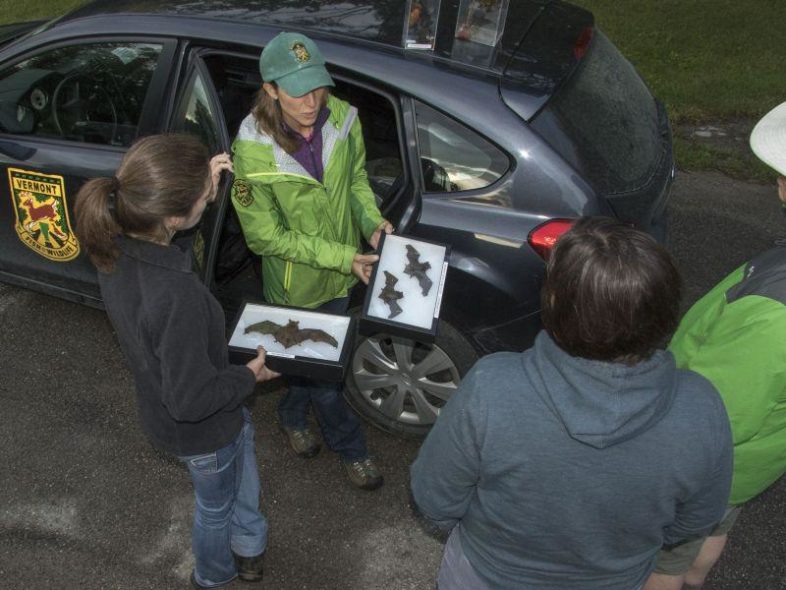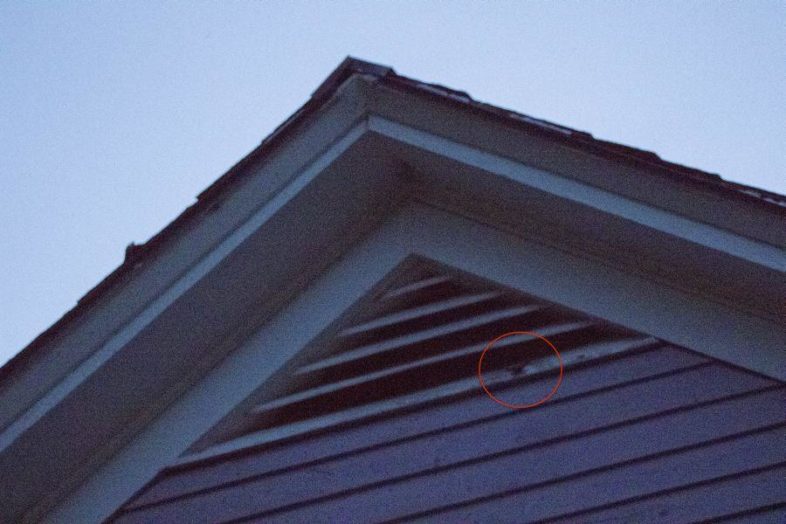
Alyssa Bennett from the Vermont Fish and Wildlife Department shows Sara the difference between Little Brown Bats and Big Brown Bats.
A bat will eat about half its weight in insects on a summer night, and it can live more than 30 years. That’s a lot of insects! But unfortunately, a disease called white-nose syndrome has taken a huge toll on Vermont’s Little Brown Bat population.
Biologists Kent McFarland and Sara Zahendra join Alyssa Bennett from the Vermont Fish and Wildlife Department, as well as two volunteer bat counters at Bomoseen State Park to count bats as they leave the maternity colony to forage for insects at dusk. They talk about white-nose syndrome, the different species of bats found in Vermont and the important role they play in our ecosystem.
Listen to the show

Little Brown Bats begin to emerge from the attic to forage for the night.
Learn more
- Vermont Fish And Wildlife Department bat information page.
- Report a bat colony in Vermont.
- Report sick or dying bats.
- Vermont Fish And Wildlife Department Bat Colony Monitoring Program.
- Guide To Identifying Vermont’s Bats.
- Vermont Fish And Wildlife Department Species Account For Little Brown Bat.
- Learn more about White Nose Syndrome.
Outdoor Radio is produced in collaboration with Vermont Public Radio.

I thought this article really interesting. Possibly something hopeful for a bat population recovery.
Jenny
Researchers close in on white-nose vaccine
Posted June 26, 2019
A new study shows that vaccination may reduce the impact on bats of white-nose syndrome, one of the most destructive wildlife diseases in modern times.
“This is a significant step forward in developing control mechanisms to combat the devastating spread of white-nose syndrome in our important bat populations,” said Jim Reilly, director of the U.S. Geological Survey, in a statement. “Being able to deliver an oral vaccine during hibernation could be a game changer in our ability to combat one of the deadliest wildlife diseases in modern times.”
The fungus Pseudogymnoascus destructans causes white-nose syndrome, which has killed at least 7 million bats in the United States since its discovery in 2006. The disease is spreading rapidly, and no cure exists. Recent studies by scientists at the USGS, University of Wisconsin, and Wisconsin Department of Natural Resources demonstrated that bats immunized against P destructans were less likely to develop WNS or die from the disease in two initial scientific trials.
Southeastern bat (Myotis austroriparius)
This southeastern bat (Myotis austroriparius) from Alabama has signs of infection with the Pseudogymnoascus destructans fungus that causes white-nose syndrome in bats. (Photo by Dottie Brown/Ecological Solutions Inc.)
The study was published May 1 in the journal Scientific Reports.
“Insect-eating bats are incredibly valuable, saving the U.S. agricultural industry billions of dollars in pest control services every year,” said USGS scientist Tonie Rocke, PhD, who led the team involved in vaccine development, in the USGS statement. “Our initial studies suggest that an effective vaccine could be a critical step towards conserving North America’s bat populations.”
During the trials, scientists administered several vaccine formulas to little brown bats prior to P destructans exposure and hibernation. They found that bats vaccinated orally or by injection survived at a higher rate than unimmunized bats. The bats also developed specific antifungal immune responses. Although work is still progressing to select the best vaccine candidates, the findings suggest that vaccination could potentially protect bats or reduce the effects of white-nose syndrome by providing them with immunity against P destructans.
“This work shows the importance of multi-disciplinary teamwork when dealing with devastating diseases such as white-nose syndrome,” said Dr. Jorge Osorio, a professor at the University of Wisconsin-Madison School of Veterinary Medicine, in the USGS statement.
In natural environments, vaccines could be applied to bats in a jellylike substance that they would ingest as they groom themselves and each other. Treated bats would also transfer the vaccine-laden jelly to untreated bats.
“These results represent an exciting step forward, not only for managing white-nose syndrome but for treating disease in wildlife,” said Jeremy Coleman, PhD, national coordinator for white-nose syndrome for the U.S. Fish and Wildlife Service, in the USGS statement. “Vaccine development is among multiple options the Service is funding to treat white-nose syndrome, but it is one that holds great promise for heavily affected bat species.”
Copyright © 2019 American Veterinary Medical Association